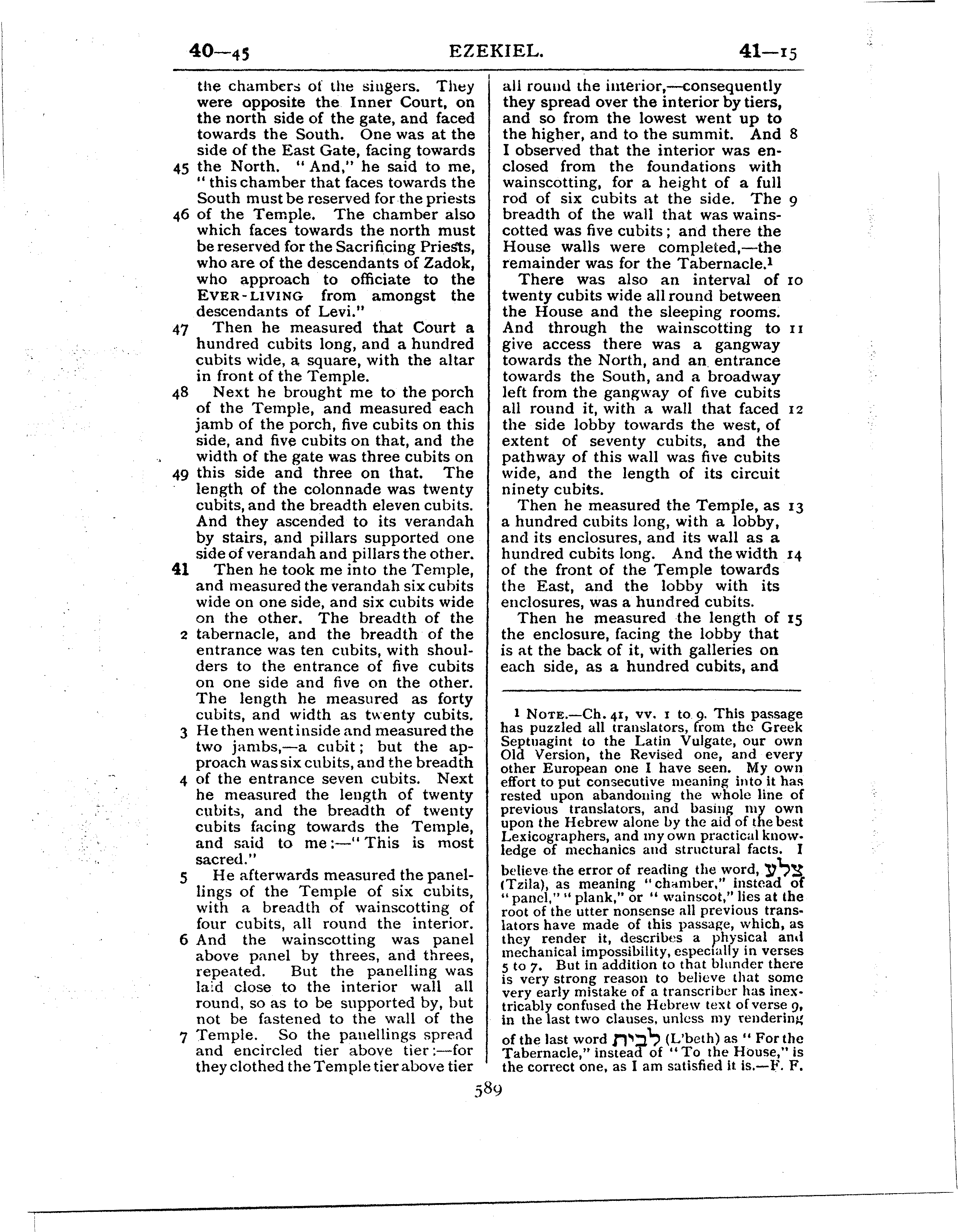Ezekiel - Ferrar Fenton Bible Translation page 589
The Books of the Prophets
41
the chambers of the singers. They were opposite the Inner Court, on the north side of the gate, and faced towards the South. One was at the side of the East Gate, facing towards he said to me, ‘ this chamber that faces towards the South must be reserved for-the priests of the Temple. The chamber also which faces towards the north must be reserved for the Sacrificing Priests, who are of the descendants of Zadok, who approach to oiiiciate to the EvEa—x.1vmo from amongst the descendants of Levi. Then he measured that Court ahundred cubits long, and a hundred cubits wide, 3. square, with the altar in front of the Temple. Next he brought me to the porch
of the Temple, and measured each jamb of the porch, five cubits on this side, and five cubits on that, and the width of the gate was three cubits on this side and three on that. The length of the colonnade was twenty cubits, and the breadth eleven cubits. And they ascended to its verandah by stairs, and pillars supported one side of verandah and pillars the other. Then he took me into the Temple,
and measured the verandah six cubits w-ide on one side, and six cubits wide on the other. The breadth of the tabernacle, and the breadth of the entrance was ten cubits, with shoul- ders to the entrance of five cubits on one side and five on the other. The length he measured as forty cubits, and width as twenty cubits. He then wentinside and measured the two jarnbs,~——a cubit; but the ap- proach was six cubits, and the breadth of the entrance seven cubits. Next he measured the length of twenty cubits, and the breadth of twenty cubits facing towards the Temple, This is most He afterwards measured the panel-
lings of the Temple of six cubits, with a breadth of wainscotting of four cubits, all round the interior. And the wainscotting was panel above panel by threes, and threes, repeated. But the panelling was laid close to the interior wall all round, so as to be supported by, but not be fastened to the wall of the Temple. So the panellings spread and encircled tier above tier :—~for they clothed the Temple tier above tier all round the iinei·ior,·-consequently they spread over the interior by tiers, and so from the lowest went up to the higher, and to the summit. And 8 I observed that the interior was en- closed from the foundations with wainscotting, for a height of a full rod of six cubits at the side. The breadth of the wall that was wains- cotted was five cubits; and there the House walls were completed,—··the remainder was for the Tabernacle. There was also an interval of
twenty cubits wide all round between the House and the sleeping rooms. And through the wainscotting to give access there was a gangway towards the North, and an, entrance towards the South, and a broadway left from the gangway of Hve cubits all round it, with a wall that faced the side lobby towards the west, of extent of seventy cubits, and the pathway of this wall was five cubits wide, and the length of its circuit ninety cubits. Then he measured the Temple, as
a hundred cubits long, with a lobby, and its enclosures, and its wall as a hundred cubits long. And the width of the front of the Temple towards the East, and the lobby with its enclosures, was a hundred cubits. Then he measured the length of
the enclosure, facing the lobby that is at the back of it, with galleries on each side, as a hundred cubits, and IO II I2
1 Nora.-—Ch. 4x, vv. x to g. This passage
has puzzled all translators, from the Greek Septuagint to the Latin Vulgate, our own Old Version, the Revised one, and every other European one I have seen. My own edort to put consecutive meaning into it has rested upon abandoning the whole line of previous translators, and basing xu own g upon the Hebrew alone by thc aid of Le best Lexicographers, and my own practical know- ledge of mechanics and structural facts. I berlicvethe error of reading the word, ]7Bg instead of lies at the root of the utter nonsense all previous trans- lators have made of this passage, which, as they render it, describes a physical and mechanical impossibility, especially in verses 5 to 7. But in addition to that blunder there is very strong reason to believe that some very early mistake of a transcriber has inex- tricably confused the Hebrew text ofverse g, in the last two clauses, unless my rendering For the is the correct one, as I am satisfied it is.-·—F. F. 589
